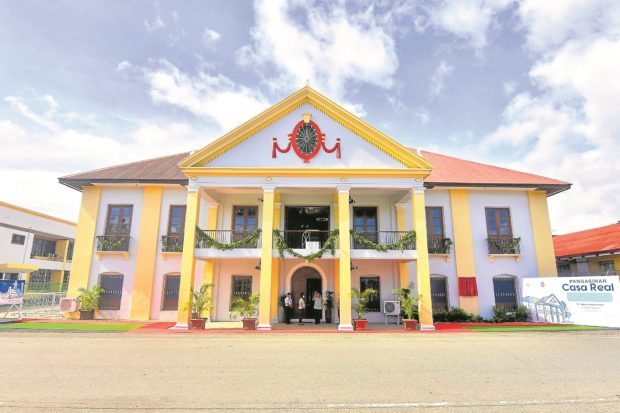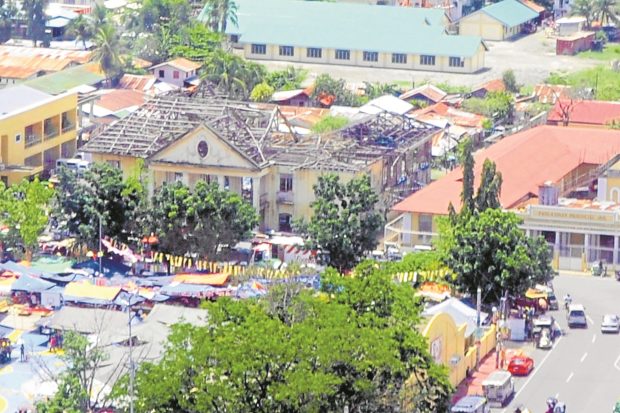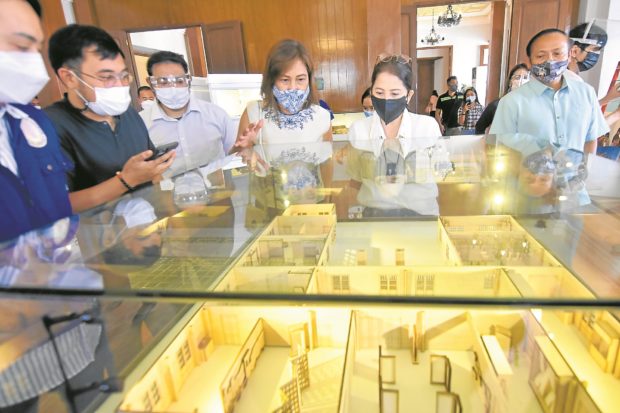Reviving Casa Real

LINGAYEN PRIDE Casa Real, which symbolized power in Pangasinan province during the Spanish era, has been turned over to the provincial government this week after its full restoration. —PHOTOS BY WILLIE LOMIBAO
LINGAYEN, Pangasinan, Philippines — As soon as the massive door of Casa Real (Royal House) is opened, one is transported to the era when Spaniards ruled the country and government buildings had spacious halls, when intricately designed high ceilings were accented with elaborate chandeliers, and floors were covered with handmade Machuca tiles.
Like most Spanish edifices, Casa Real is built with bricks and stones with ornate ceilings and staircases made of piedra china (granite stone) with wooden balustrades. From the outside, Casa Real with its wide veranda, is as imposing and as stately when it was constructed 200 years ago.
It was in the 1840s when Casa Real was built by the Spanish colonial government, dominating the landscape of the heart of the Pangasinan capital of Lingayen. Its roof was made of cogon grass during its early years but corrosion-resistant zinc roofs were installed in the 1890s.
For years, the two-story building served as Pangasinan’s seat of power. The alcalde mayor held his office there as head of the province and as judge of the Court of First Instance.
But the Americans came in the early 1900s and built a neoclassical building near the beach to replace Casa Real as the provincial capitol. In 1918, the seat of power was transferred to the new building.
Article continues after this advertisementCasa Real was relegated to being an elementary school for several years, while some of its sections continued to function as courtrooms. Then again, the Justice Hall was built in 1996 near the new capitol so another occupant, the courts, left the building.
Article continues after this advertisement
An undated image from the collection of Arabela Arcinue (above) shows the historical landmark in its earlier years in the capital town of Lingayen. Itwas built during the 1840s and served different purposes as provincial capitol, school building, courthouse and headquarters of the Japanese during World War II.
Historical landmark
In 2007, the importance of the edifice as a historical landmark in the town came to the fore when local historian Arabela Arcinue, president of Pangasinan Heritage Society Inc. (PHSI), saw a photo of Casa Real in Philippine Picture Post Cards, a collection of 1900 to 1920 postcards by Jonathan Best.
It was then that Arcinue, who was born and raised in Lingayen, realized that her town had a valuable edifice that was taken for granted through the years, said Nathaniel Joel Daroy, culture and arts officer of the provincial government.
But just as PHSI was advocating for the rehabilitation of the long neglected building, severe Tropical Storm “Cosme” (international name: Halong) struck in 2008, blew the roof away and drenched everything inside. The government agencies still maintaining offices there had to leave.
As it turned out, Casa Real, which survived earthquakes and World War II, was not strong enough to withstand Cosme, leaving it in a sorry state. Worse, illegal settlers occupied the back portion of its grounds and looted whatever they could from the building.
The PHSI had sought permission from the provincial government to allow it to look after building, even assigning a guard to secure the property. But the group ran out of funds and, once more, the structure was left to the elements and for the illegal settlers to pillage.
The PHSI did not give up on its dream for Casa Real to regain its lost glory.
In fact, it was as early as 2002 when the National Historical Institute (NHI), the predecessor of the National Historical Commission of the Philippines (NHCP), had declared Casa Real a national historical landmark, at the behest of the Lingayen Soroptimist Society.
NHI Resolution No. 5, dated March 13, 2002, described the building as “an outstanding and unique example of civic architecture from the Spanish colonial period … [which] to this day [is] a beautiful monument to the artistry, craftsmanship and ingenuity of the builders.”

ABANDONED In this photo taken in 2010, Casa Real, at the heart of Lingayen town, is still without a roof two years since the onslaught of Tropical Storm “Cosme.”
‘Showcase of neglect’
Yet, it took nearly a decade before the government took another glance at the building.
In 2010, then newly elected Pangasinan Rep. Leopoldo Bataoil was looking around the capital town when he saw Casa Real.
“It was at the centerstage of Lingayen, but it was a showcase of neglect,” Bataoil, now the town mayor, told the Inquirer.
Right then and there, he decided that the historical building needed reconstruction and restoration.
He asked the provincial government, then headed by Gov. Amado Espino Jr., to finance the project, and P5 million was immediately appropriated for Casa Real’s repair.
Restoration
But the amount was not enough to restore the building, so Bataoil had to ask for funding from “friends.”
It so happened that the late Ludovico Badoy, then executive director of the NHCP, was also the mayor of Cotabato City (1986 to 1998) during the time when Bataoil, a retired police officer, was the city’s chief of police.
“I approached him about the project, and he saw the Casa Real’s historical significance and allotted P30 million for its restoration,” he said.
He went next to the Tourism Infrastructure and Enterprise Zone Authority (Tieza), which earmarked another P33 million.
In 2015, the provincial government, the NHCP, the Tieza and the Department of Public Works and Highways (DPWH) came together to plan the restoration.
“But first, we had to relocate the 44 families who have illegally settled at the back [of the building],” Bataoil said.
The settlers were finally convinced to leave the area and the provincial government gave them lots at a housing project site in another village.
Restoration began the following year. The first phase included general clearing and grubbing works, putting a temporary perimeter fence, and concreting of columns.
The next phase was primarily done by the DPWH, which closely coordinated with historical agencies to ensure the structural work would adhere to “national and international standards of structural conservation and restoration.”
The third and last phase, funded by the Tieza, involved the final site development of Casa Real and its surroundings.
The restoration tried to be as faithful to the original design as possible, said Daroy.
However, since the building was looted to its barest and many parts were destroyed through the years, the government had to look for other suitable materials for the restoration work.
For instance, the ornate ceilings made of tin imported from Belgium was replaced with fiberglass designed by local artisans.
Some rooms were retiled with salvaged handmade Machuca tiles. But since many of the old tiles were broken during the restoration, some rooms were fitted with new ones.

TOURISM CENTERPIECE Tourism Secretary Bernadette Romulo Puyat (second from right) views a diorama inside the newly restored Casa Real following the building’s inauguration. Casa Real is being developed to become one of the major tourism attractions in Pangasinan.
Back to old glory
According to Daroy, the building was retrofitted with posts to strengthen the structure.
The reconstruction and restoration project was completed in 2019, but subsequent events, including the COVID-19 pandemic, set aside any plan to inaugurate the restored Casa Real.
Finally on June 21, Casa Real came back to life. It was inaugurated by Tourism Secretary Bernadette Romulo Puyat, NHCP Director Rene Escalante, Pangasinan Gov. Amado Espino III and Bataoil.
Casa Real will serve as the town’s museum and local authorities are asking residents to donate whatever relics they have in their possession for display.
Some items from the old building found during the construction are on display on the second floor. These include twisted steel, iron wood staple, iron nails, pieces of wood, and tiles.
The backyard, where illegal settlers used to stay has been transformed into a park.
Soon, Casa Real will welcome the public.